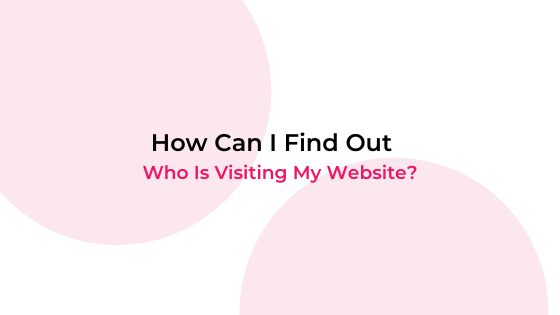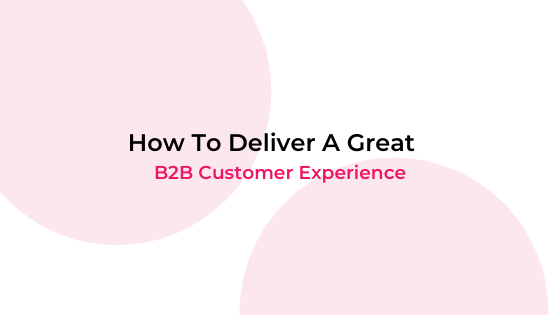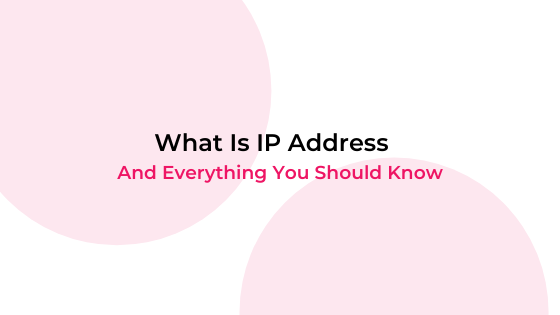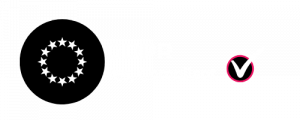What Is B2B Sales? A Complete Guide – in this piece of content, you will deeply understand how a sales funnel works and the full process of ‘selling’, specifically for the B2B market, going through the following steps:
- What Is B2B Sales?
- What Are The Advantages Of B2B Sales Model?
- The Biggest Challenges Of The B2B Sales Model
- How The B2B Sales Cycle Works
- Differences Between Inbound Sales And Outbound Sales
- Practical Tips To Optimize Your Sales Cycle
- B2B Sales Channels
Advance through these topics and make sure that you’re going to win your customers at each stage of the journey.
What is B2B Sales?
By definition, the Business to Business model, or B2B, is a business model in which sales are made between companies, and not to the end consumer — as with B2C.
Whois, for example, is a B2B business. We have a SaaS lead generation product that identifies your real-time website visitors, and we market only to companies.
In B2B businesses, sales are more complex and the time to purchase is much longer, which creates an extra challenge: predicting revenue and adjusting cash flow for a sales cycle that can (and usually will) take weeks or even months.
To move from one supplier or project to another, the process involves resources such as time, people and money that is available to the company.
This cycle generally considers: the time until the purchase, recurrence, the size of the sale, the decision makers.
Therefore, the decision to purchase is longer than that of an end consumer.
What Are The Advantages Of A B2B Sales Model?
In general, B2B sales tend to generate business with higher values than those made directly to a consumer.
But, in addition to these, we can highlight two other major advantages here: the greater possibility of loyalty and the selling company having recurring revenue. Why that?
Higher average ticket
B2B sales tend to generate much higher revenues than B2C sales.
One reason is that the quantity of products (when it comes to products) purchased tends to be greater.
In addition, the solutions are more specific and robust, punctual for the business, which adds even more value to what is being marketed.
Longer lasting relationships
As we mentioned earlier, cost-benefit analysis is often more in-depth in B2B sales. This makes the company that is buying better evaluate the one that is selling.
On the other hand, the B2B salesperson makes more efforts to win this customer, striving to present the best solutions to their problems.
In this way, the relationship between the two organizations becomes more solid and, if both comply with the contract, the possibility of loyalty is quite high.
Recurring Revenue
Cultivating this type of relationship helps the B2B Business to have a more recurring revenue.
This advantage is even more evident when there are long commercial agreements, for example, regular supply of a product or support of a service.
The Biggest Challenges Of The B2B Sales Model
The main challenges can be summarized, basically, in three: knowing in depth the business of the purchasing company, dealing with decision makers and having excellent time management.
Get to know the buying company’s business in depth
It is indicated that the B2B salesperson knows as much as possible how the company that is trying to sell acts for.
Thus, the salesperson will have enough information to diagnose the problem of the potential customer and, thus, offer the most appropriate solution.
In addition, good information about the buying company will give you negotiation arguments, and this preparation helps your proposal to stand out from other competitors.
Dealing with decision makers
The decision to buy a company will rarely be made by a single person.
Therefore, it is up to the B2B seller to have the patience and persistence necessary to make the sale.
Because, most of the time, it is difficult to have direct access to whoever makes the final decision.
Thus, it is necessary to have a match and know the product or service you are offering in order to have more and more convincing arguments.
Excellent time management
Unlike a B2C sale, B2B demands more negotiation time. For this reason, it can be easy for the salesperson to “get lost” in the middle of the process.
In order to know exactly when to approach the client, remember your proposal, or give the client time to consider it, it is essential to have good time management.
A good way to know how to act in each step of the sales funnel is using CRM software, for example.
It consists of a system that allows the centralization of all customer information and interactions, facilitating service and improving the relationship.
Of course, these challenges are far from impossible to achieve.
But they are crucial points to maintain attention and the pillars of the success of a B2B business — knowing in depth the business of the purchasing company, dealing with decision-makers, and having excellent time management.
Getting To Know The B2B Sales Cycle
Sales cycle is the average time that your company takes to close a sale.
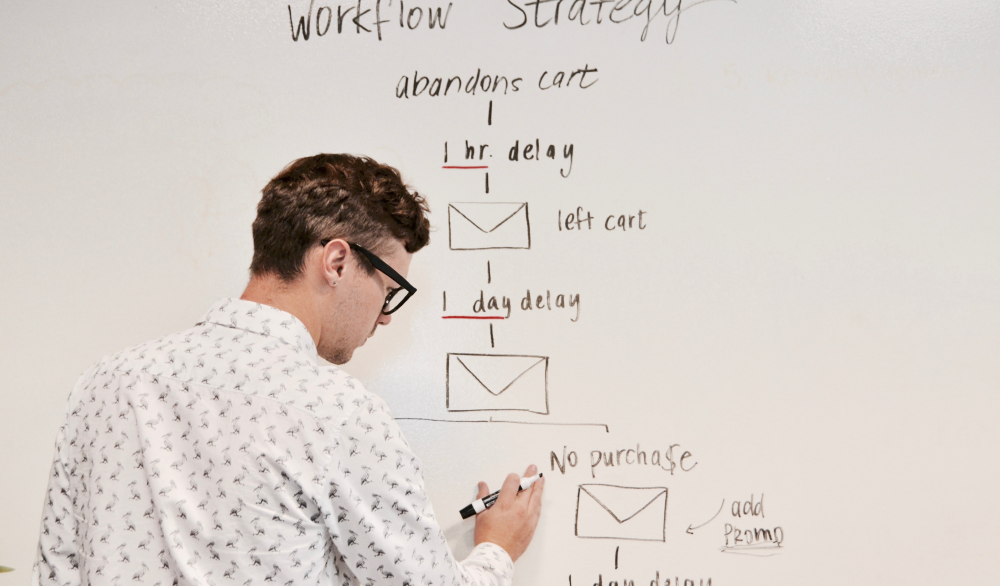
The sales cycle concept considers the period between the initial contact between the company and a customer, the identification of the services to be purchased, the acceptance of the intended purchase and the transaction that concludes the sale.
Even though it goes through the same steps — prospecting, qualifying, offering, negotiating, closing and after-sales — the end of the sales journey between two companies tends to take longer.
And this is because the purchase decision usually involves many people, for example, buyer, area manager, finance department, etc.
For this reason, B2B sales tend to be more rational and the cost-benefit analysis ends up being much more in-depth.
That’s why it is very important that the B2B seller considers, in addition to the company’s needs, the characteristics of the professional buyer – which, depending on the profile, can make the process even longer.
In addition to helping to monitor the efficiency of the sales process, a sales cycle helps to optimize and organize each step: what needs to be done in relation to a specific lead, when to make the purchase proposal, among others.
All the follow-up done through the sales process gradually forms some patterns on the habits of a company’s customer profile.
Because it involves constant contact with the leads, the sales cycle helps to understand their situation and understand what the most latent pains are.
This practice is called the sales cycle because it is repetitive and constant.
That is why, after a while, sales begin to be more predictable and we are able to measure indicators, such as: average number of conversions, closings at a certain time, constant average ticket, among others.
Also, it’s very important to analyze the habits of your leads, as this makes it easier to know where to find them and to define which communication channels will be more efficient.
Along with that, be aware of what actions make a lead progress through the sales funnel more quickly, so that they can be integrated into the cycle.
Before setting up your sales cycle, it’s interesting to do a joint analysis of the previous sales processes, to get an idea of the pattern of time taken to close each deal and what factors — strategies used, type of product, lead profile — increase or shorten that period.
The 5 Essential Stages Of The Sales Pipeline For B2B
Of course, each type of business requires its own sales processes, but when the product is a SaaS developed for companies, for example, these stages of the pipeline cannot be missed.
Check out:
- Prospecting: to take visitors to your site to this stage, your marketing team must work with Inbound and Outbound methods to capture contacts who possibly have a problem that your SaaS can solve;
- Qualifying Prospect: the stage at which the lead needs to be evaluated according to your Buyer Persona, the objectives of the possible customer, the functionality of your SaaS, among others. During this period, the marketing team must present the qualities and values of your product or service, to show you how to help you solve the problem identified in the first stage;
- Demo Meeting: at this point, it’s necessary to make sure that the customer has a need and that this will be solved by the product. From then on, the sales team gets in touch to better understand how the product can serve the client’s company and which plans and values are recommended;
- Proposal/Trial: after confirming that SaaS will actually solve your lead’s problems, some companies choose to offer a Free Trial. This is a great selling point because, in addition to showing confidence in your product, it gives more freedom to the lead who is still unsure about the SaaS features;
- Closing: With the delivery of what is promised — a great product, committed customer service, and ongoing support — the chances of closing the deal are great. Even better when SaaS B2B aims to delight the customer in each interaction. Thus, the sales possibilities are even greater.
Even if the final result is not the sale, a good idea is to remain on the customer’s radar, without disturbing them.
It may be that in the future SaaS B2B will incorporate more functions in the software, that meet the prospect, and get them to subscribe to your company’s service.
You may have noticed that working with your brand in the B2B space requires patience and strategy. You need to know where to optimize your brand to educate, cultivate and convert your different levels of leads.
This may require a balance between brand awareness and targeting specific users to convert them into leads through your journey.
Your company must create content that educates and nurtures your audience about your service — we’ll talk more about the Inbound Process below.
Also read: Sales Process – Why It Is Important For Business Success
But depending on where they are in the B2B sales cycle, the way your company approaches them needs to be different.
Before we continue, just a reminder: to better accommodate the longer B2B sales cycle, it is important to distinguish between demand generation and lead generation campaigns.
- Demand Generation: the focus is on marketing programs aimed at generating awareness and interest in a company’s products and/or services;
- Lead generation: the action or process of identifying and cultivating potential customers for a company’s products or services.
In this process, it is important to note that lead generation will be more difficult when your company does not correctly create a demand generation campaign.
Without the initial pull of demand generation, your audience will not be educated enough to be converted into leads.
Understand The Differences Between Inbound Sales And Outbound Sales

Stages Of Inbound Sales
The wide dissemination of information changed the logic of content consumption, as well as consumers’ purchasing behavior.
It was with the popularization of content marketing and the development of marketing automation tools that the Inbound Sales methodology emerged.
If before this the knowledge was in the hands of the sellers, today it is with the buyers, who have a vast repository of information: the internet.
And if the customer now has a greater knowledge of the market and product at the time of the purchase decision, businesses are forced to produce informative content for their potential buyers.
Read more: How to get to know your ICP (Ideal Customer Profile)?
This created attraction marketing, the pillar of inbound marketing.
The Inbound Sales are based on 5 pillars: Personas Definition, Sales Funnel, Content Production, Automation, and Measurement.
- Personas Definition: consists of mapping the archetypes of potential customers, with all their pains throughout the purchase journey;
- Sales Funnel: the client goes through different stages and when it comes to Inbound Marketing a hypothetical funnel is worked with the following steps: attraction, lead generation, conversion, and loyalty;
- Content Production: consists of producing content, systematically, for each persona, in their different stages of the marketing funnel. Here it is worth blog posts, ebooks, webinars, infographics, whitepapers, spreadsheets, and more;
- Automation: this whole process gains commercial intelligence with incredible automation, which allows you to offer landing pages, the sequence of emails, lead scoring according to the profile and stage of the client;
- Measurement: all Inbound Marketing and sales work is guided by results monitoring. Every step must be measured.
Read more: B2B Content Marketing: brilliant ways to grow your business
It turns out that producing highly segmented content, being a source of education for the customer and moving the lead in the purchasing process according to their speed seemed to be revolutionary and an infallible plan to unite marketing with sales.
After all, in this way, it would be marketing that would dictate the entire lead generation strategy for companies.
However, Inbound Sales is limited when used as the only sales strategy. Here’s why:
- It may generate poor quality leads: marketing was charged for generating leads, based on the personas previously defined. Reality has shown that quantity isn’t quality. Sales need good leads, not a ton of leads that won’t buy. And when it comes to the inbound process, you don’t choose leads!
- The marketing funnel is not optimized for B2B businesses: B2B sales are complex sales, where countless buyers participate in the decision-making process. In the inbound marketing funnel, this complexity of multiple buyers is generally ignored.
- The consumer’s journey is not linear: inbound marketing plans and as a result of inbound sales consider a customer journey practically linear, that is, customers move from one stage to another of the funnel in a sequential manner. Reality has not demonstrated this. A customer may download funnel bottom material and not even want to talk to someone on the sales team.
Outbound B2B Sales techniques
Outbound is the most traditional model and consists of actively prospecting customers.
In general, in outbound prospecting, leads are not waiting for your contact and probably don’t know your company yet.
This prospecting of customers can be done either by phone or in person.
The advantage is that it is an active process, that is: you can reach leads that would not reach you in any other way.
The disadvantage is that the outbound prospecting is less scalable, since the number of leads depends on the productivity and the size of the team of salespeople dedicated to the task.
In practice, the model works like this:
B2B company with high ticket and long sales cycle: the cost of acquiring the outbound strategy is usually higher, but with a high ticket it is possible to pay for it.
The personas of these companies tend to be more specific and detailed, so an outbound strategy can make sense.
B2C company with low ticket and fast sales cycle: the objective in this case is volume. The most used actions end up being prospecting by telemarketing and TV and radio ads.
The negative point is that, due to the high volume, many leads will be “burned” during the process — only those who really have an immediate interest will remain at the base.
For the outbound approach to work, you need a minimum structure to deploy: master cold calling 2.0, know the Predictable Revenue methodology, Dedication to build your lead base and of course service with excellence.

- Master Cold Calling 2.0
Basically, the process of cold calling 2.0 is sending a personalized email to your prospect.
If the email had a response of interest, then the phone call comes in. If not, follow with a cadence of follow-ups to try to get the prospect’s attention.
Some principles of how to write a good cold email:
- The focus is on the person and not the sale — focus on talking about the specific challenges of that role with whom you are talking and not what you want to sell;
- Be original in the subject field to increase the open rate of the email, without delivering the purpose of the message. Also, do not report a subject that is not related to the message;
- Plain text without templates — cold email is not email marketing;
- Short but purposeful message — large emails tend to be ignored in the first few lines;
- Send the email directly from the box of a customer’s employee (no generic address like contact@business.com);
- End the email with a call to action — and it is worth saying here that the call to action should not be to direct a website to sell the services, but rather, to answer the email or make a call to create a connection and go deeper into the needs of those being prospected.
Also read: How-to Guide: Improving Your Cold Calling Result
2. Dedication To Build Your Lead Base
It is important that the company has a professional dedicated to outbound.
Otherwise, the professional needs to have enough time to dedicate himself to the functions involved in outbound, especially in building the lists of prospects.
3. Know The Predictable Revenue Methodology
Cold calling 2.0 is part of the Predictable Revenue methodology created by Aaron Ross and tested and approved by numerous companies around the world.
It broke down paradigms, redesigned the outbound, turned into a book and is considered the sales bible.
When You Should Use Inbound Or Outbound Sales In Your Strategy?
The answer to this question varies for each type of business and also for the commercial strategy.
To come up with an answer, it is worth answering a few points:
- Where are my customers?
- Can I reach them easily? How much does it cost to do this?
- How many leads do I need per month to hit my goals?
- How is my marketing structured today? Do I have good materials that support my sales team?
- How big is my sales team? What volume of leads can they handle?
- What does the current lead acquisition cost?
- And the cost of the different channels?
- Can I name my company’s Ideal Customer Profile (ICP) well?
After analyzing these responses, we can add that in Inbound sales you tend to get to know customers more, as they left a lot of information about their pains and needs as they evolved in the commercial funnel.
However, knowing more about this ICP is not necessarily a good deal, as this doesn’t guarantee that it’s a good lead.
In Outbound Sales, however, there is a tendency to prospect for the types of customers that your company needs, however, they will not necessarily be prepared to buy.
There is a risk that they simply don’t need your product or service.
Given that both Inbound and Outbound methodology have good pros and cons, the final tip is to bring both approaches together in a coordinated manner.
In some companies Inbound Sales will have greater weight, in others, it will be the Outbound strategy that will dictate the way of selling.
Assessing how to assemble this combination in the correct dosage is the great challenge facing marketing and sales professionals in companies today.
Also read: Sales And Marketing – Ten Ways To Align The Departments
Some Practical Tips And Actions To Optimize Your Sales Cycle
As a matter of fact, in addition to converting new customer sales more quickly, another fundamental goal of sales cycle management is order renewal.
After closing the first sale, you go back to the beginning, to sell and open the cycle again.
Then, the after-sales and loyalty work begins, always with three objectives in mind:
- Sell a larger average ticket;
- Sell more times;
- And sell for longer.
In the case of optimizing the sales cycle, the focus is on selling more times in the same period of time.
To speed up the sales cycle, you need to work through all the steps in your sales funnel.
Check out the three main segments, related to the sales funnel, and what effective actions that can be used in the day to day of your business in each of them.
Actions For The Top Of The Funnel
At this stage, people interested in the solution that your business offers are in a Discovery and Learning process.
Therefore, your marketing team needs to define appropriate prospecting strategies, so that these customers “discover” your company.
Then, the marketing should start to qualify the attracted leads, in order to know if it is really worth “teaching” them all the characteristics of their solution, or if they should be removed from the funnel.
You can, for example, use some lead qualification techniques used in companies, such as BANT, ANUM, GPCT, FAINT and CHAMP.
The goal here is to bring the right customer, the one most likely to see the value in your solution and, therefore, has great potential for closing.
Another important point is to define a practical way of not delivering cold leads to the sales team, facilitating their work and shortening the sales cycle.
Actions For The Middle Of The Funnel
Here we can assume that your sales funnel has a good amount of qualified leads to work with.
Many companies are part of the marketing and sales teams working together for this stage.
This is because in this intermediate stage of the sales cycle, leads are recognizing that they have a problem and, after that, start considering a solution for it.
Therefore, two types of actions can be taken:
- The marketing team can start nurturing these leads, that is, continue sending information about their solution to them;
- The sales team may think it is time to contact and make a presentation, using different types of approach.
To make this possible, you can establish some tactics that will optimize this stage of the sales cycle.
- Define customer behaviour patterns: it is based on customer data that you can identify where they are at any point in your Buyer Journey. Consolidate your sales team’s knowledge from this data and your salespeople will not waste time thinking about how to resolve certain impasses with the customer;
- Define triggers: with the help of the data you have, or at least the team’s experience, it is necessary to define what determines the next action, after each contact. For example, what defines whether leads should receive more nutrition and learning emails, or whether they should receive a call?
- Don’t block your sales cycle: sometimes you have to give up on customers. This is essential for those who want to have an agile sales cycle and not waste time with customers who do not close the sale.
Actions For The Bottom Of The Funnel
At this point, we consider that the leads are very interested, a proposal has already been sent and they are in the evaluation and purchase stage.
It’s time for salespeople to take action to negotiate and close the sale.
And this is only possible with a lot of preparation and mastery of negotiation and closing techniques.
Read more: Check These B2B Sales Techniques Tips To Grow Your Sales
At this point in your sales cycle, conversion rates have to be high.
That’s because everything that has been done before, with:
- Prospecting through the right channels;
- With the right qualification;
- The use of reliable data to define behaviours and triggers;
- And the fact that your funnel is unobstructed
Then your salespeople have everything to have a high success rate at this time.
B2B Sales Channels
Your company doesn’t only need to create content and ads that serve its end-customer: it must also apply these resources to the correct channels where the end customer is present.
Publishing content without carefully researching where your end customer is engaging and converting is a great way to waste time and resources.
Each will be involved with different content on different platforms.
And your company, through its marketing team, needs to be able to achieve both.
When it comes to successfully targeting different campaigns to different users, the rule is always the same: dive deep into personalization.
There are tons of different channels you can use in your strategy, such as:
- Email Marketing;
- Video;
- Paid Search;
- Conferences & Event Networking;
- Webinars;
- Podcasts;
- Organic Search;
- Display Ads/Retargeting;
- Content Marketing;
- Brand Partnerships;
- Website Visitor Identification.
Check out: The Benefits of Using Business IP Tracking Software
To define which channels fit best with your marketing and sales strategy, you can use the Bullseye methodology.
There are 5 steps: Brainstorming, Channel ranking, Aiming at the target, Testing, and Hit the bullseye.
- Brainstorming: gather your team, gather bibliography on the subject, relevant posts on the internet, your personal experiences and other information, and make a list of all possible channels for your business, without discriminating against any;
- Channel Ranking: now, put them in descending order, from those that appear to be the most effective and least costly and even the least promising;
- Aiming At The Target: choose a maximum of three channels to use. This is the basic premise of this methodology: focus on what works best;
- Testing: at this point, you can use CRM software and/or other data analysis tools, even spreadsheets, that will help you discover what is really working, through numbers and statistics;
- Hit The Bullseye: after evaluating the results of the three chosen channels, you can define what is really working and attracting more customers. Keep what works and improve or abandon what doesn’t work.
In this way, your prospecting will be much more agile and assertive, making this stage of the sales cycle faster and more accurate.
Outstanding Tips To Increase B2B Lead Generation And Conversion
We have already left several tips to increase website traffic and attract more leads to your database, so now we are going to share techniques that use the already known channels, but going beyond “rice and beans”.
1. Sales Is Science And Not Art
The first tip, however, is to remember that customers have purchasing processes — that should guide everything else.
There are at least 6 basic steps in this process: Research, First call, Post Call, First meeting, Post meeting, Second meeting – Present and Close. Wich means:
Research
- What should you research?
- What information is most relevant?
- Where to get this information?
- What software can help me?
First call
- What should I say?
- How long should this call last?
- Who should I talk to?
Post Call
- After the first contact, what do I do?
- Send email?
- What do I share?
First meeting
- How long should it last?
- What should be the focus?
- What goal do I want to achieve?
Post meeting
- What should I do after my meeting?
- Should I send an email?
- Should I call?
- Proposed shipping?
Second meeting – Present and Close
- Do I do it by phone or in person?
- How to drive?
- How long should it last?
That’s because the more aligned the steps of the pipeline are to the customer’s purchasing process, the less friction is generated and the greater the conversion.
In addition, reaching sales goals is a consequence of a number of factors, such as lead quantities, conversion rates, duration and cross-step passes, among others.
2. Look For Elements To Generate Rapport With Your Leads
With the easy access to information available on the internet, it is much easier to generate rapport with a lead.
It’s worth investing time on LinkedIn to check the companies the lead worked for, contacts that exist in common, content they liked, events they participated in, etc.
Also read: Here Are 5 Of The Best Linkedin Tools For Prospecting (And Generating Leads)
And it’s also important to break the ice as early as possible so that the conversation helps the lead to feel more comfortable and trust the salesperson more.
3. Use break-ups at different stages of the process
One of the most common things is that the lead simply disappears at a certain stage in the business process — stop responding to emails or always be busy when you call.
In such cases, it is worth using the “break-up” — a message that politely ends the relationship due to lack of return.
Something that makes it clear that you are doing this because of this lack of return, but that you are open for future negotiations, if the lead wishes.
After the break-up is sent, it is recommended to discard the deal in the CRM and only reopen it if the lead makes contact again.
4. Make your leads say “yes” throughout the process
The approach to leads should always be conducted in a way that encourages them to speak most of the time — for this, the salesperson must ask the right questions, know how to listen, record what the leads say.
Even in the stages where the salesperson speaks more — presenting the solution, for example — it’s valid to take breaks, ask questions to the leads, especially questions that lead them to answer “yes”.
It goes from rhetorical questions like “Is everything alright so far?” To questions that can serve as triggers to move on to the next step, such as “Do you believe that the solution I showed you now can solve the problem we mapped on the other call?”.
In addition to the positive effect that “yes” brings to the conversation, the salesperson is able to further commit the lead to the process.
5. Make sure you don’t get stuck in these mistakes
For anything to work, it is necessary to analyze the results and define indicators that will help guide your business strategy and actions.
For B2B prospecting it couldn’t be different. But this is difficult for a few reasons:
- Lack of goal setting: many companies that invest in prospecting do not even set goals and objectives. If you do not know what you are looking for, there is no way to measure indicators or to know what is working or not;
- Lack of strategy: it is common for companies that prospect to shoot everywhere, without a specific niche focus to be attacked and ideal customer profile;
- People assigned to the wrong role: one of the biggest reasons why prospecting doesn’t work is to place salespeople who have revenue targets to beat, to prospect;
- The large volume of activities: probably the biggest villain in the prospecting analysis is the large volume of activities involved in this stage of the commercial process.
Measuring so many indicators is no easy task.
However, when we talk about predictability in lead generation, pipeline, and revenue production, there is no other way.
Of course, it is not necessary to have a complete prospecting BI to start with — just looking to measure and optimize the prospecting indicators, the company is already on the right path.

